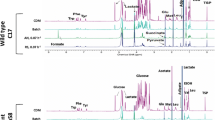Abstract
Proteus vulgaris and P. mirabilis were grown anaerobically on glucose in the absence or presence of dimethylsulphoxide (DMSO) as electron acceptor or on (S)- or (RS)-lactate in the presence of nitrogen (N)-oxides, sulphur (S)-oxides or pyruvate. During growth on glucose the main fermentation product was ethanol and in the presence of DMSO it was (R)-lactate. Growth on (RS)-lactate led to acetate and (R)-lactate and growth on (S)-lactate produced almost only acetate. Depending on the growth medium, in crude extracts of P. vulgaris the activities of (R)-2-hydroxycarboxylate viologen oxidoreductase (HVOR), measured as (R)-lactate dehydrogenase, and DMSO reductase were 0.5–8.0 and 0.3–1.1 units (U)/mg protein, respectively. Addition of nitrate to the growth medium diminished both enzyme activities to <0.1 U/mg protein. P. mirabilis showed also high HVOR activity when grown on (RS)-lactate in the presence of DMSO. Also, Clostridium homopropionicum contained 1.8 U/mg of a pyridine-nucleotide-independent reversible (R)-lactate dehydrogenase when tested with the electron acceptor 1,1′-carbomoylmethylviologen (NH2CO-MV). None of the organisms studied were significantly active with (S)-lactate and NH2CO-MV. The possible physiological role of the HVOR may be as a dissimilatory (R)-lactate dehydrogenase.
Similar content being viewed by others
References
Clark DP (1989) The fermentation pathways of Escherichia coli. FEMS Microbiol Rev 63:223–234
Dörner C, Schink B (1990) Clostridium homopropionicum sp. nov., a new strict anaerobe growing with 2-, 3-, or 4-hydroxybutyrate. Arch Microbiol 154:342–348
DSM (1989) Catalogue of strains German Collection of Microorganisms and Cell Cultures, Braunschweig
Fraisse L, Simon H (1988) Observations on the reduction of non-activated carboxylates by Clostridium formicoaceticum with carbon monoxide or formate and the influence of various viologens. Arch Microbiol 150:381–386
Gawehn K (1984) d-(—)-Lactate. In: Bergmeyer HU (ed) Methods of enzymatic analysis, vol 6, 3rd edn. Verlag Chemie, Weinheim, pp 588–592
Günther H, Neumann S, Simon H (1987) 2-Oxocarboxylate reductase from Proteus species and its use for the preparation of (2R)-hydroxy acids. J Biotechnol 5:53–65
Hummel W, Kula MR (1989) Dehydrogenases for the synthesis of chiral compounds. Eur J Biochem 184:1–13
Kallwass KW (1992) Potential of R-2-hydroxyisocaproate dehydrogenase from Lactobacillus casei for stereospecific reductions. Enzyme Microb Technol 14:28–35
Kim MJ, Whitesides GM (1988) L-Lactate dehydrogenase: substrate specificity and the use as a catalyst in the synthesis of homochiral 2-hydroxy acids. J Am Chem Soc 110:2959–2964
Kröger A (1974) Electron-transport phosphorylation coupled to fumarate reduction in anaerobically grown Proteus rettgeri. Biochim Biophys Acta 347:273–289
Kunst A, Draeger B, Ziegenhorn J (1984) d-Glucose. In: Bergmeyer HU (ed) Methods of enzymatic analysis, vol 6, 3rd edn. Verlag Chemie, Weinheim, pp 163–172
Lamprecht W, Heinz F (1984) Pyruvate. In: Bergmeyer HU (ed) Methods of enzymatic analysis, vol 6, 3rd edn. Verlag Chemie, Weinheim, pp 570–577
Molinari R, Lara FJS (1960) The lactic dehydrogenase of Propionibacterium pentosaceum. Biochem J 75:57–66
Neumann S, Simon H (1984) On a non-pyridine nucleotide-dependent 2-oxoacid reductase of broad substrate specificity from two Proteus species. FEBS 167:29–32
Ogata M, Arikara K, Yagi T (1981) d-Lactate dehydrogenase of Desulfovibrio vulgaris. J Biochem 89:1423–1431
Read SM, Northcote DH (1981) Minimization of variation in the response to different proteins of the Coomassie blue G dye-binding assay for protein. Anal Biochem 116:53–64
Schaller KH, Triebig G (1984) Determination with formate dehydrogenase. In: Bergmeyer HU (ed) Methods of enzymatic analysis, vol 6, 3rd edn. Verlag Chemie, Weinheim, pp 668–672
Schinschel C (1992) Verfahren zur präparativen Darstellung von Pyruvat aus d-Lactat mit Proteus vulgaris. PhD Thesis, Technical University, Munich
Schummer A, Yu H, Simon H (1991) Polyfunctional (R)-2-hydroxycarboxylic acids by reduction of 2-oxo acids with hydrogen gas or formate and resting cells of Proteus vulgaris. Tetrahedron 47:9019–9034
Skopan H, Günther H, Simon H (1987) A biocatalyst for the preparation of (R)- and (S)-hydroxycarboxylic acids. Angew Chem Int Ed Engl 26:128–130
Srinivas SP, Rao G, Mutharasan R (1988) Redox potential in anaerobic and microaerobic fermentation. In: Erickson LE, Fung DYC (eds) Handbook on anaerobic fermentation. Dekker, New York, pp 147–186
Styrvold OB, Strøm AR (1984) Dimethylsulphoxide and trimethylamine oxide respiration of Proteus vulgaris. Arch Microbiol 140:74–78
Taguchi H, Ohta T (1991) d-Lactate dehydrogenase is a member of the d-isomer-specific 2-hydroxyacid dehydrogenase family. J Biol Chem 266:12588–12594
Tarbell DS, Weaver C (1941) The condensation of sulfoxides with p-toluenesulfonamide and substituted acetamides. J Am Chem Soc 63:2939–2942
Thanos I, Bader J, Günther H, Neumann S, Krauss F, Simon H (1987) Electroenzymatic and electromicrobial reduction: Preparation of chiral compounds. Methods Enzymol 136:302–317
Valentine-Serano A, Hudspeth MES, Meganathan R (1991) Reduction of N-oxides and sulfoxide by the same terminal reductase in Proteus mirabilis. Curr Microbiol 23:271–276
Zinder SH, Brock TD (1978) Dimethylsulfoxide as an electron acceptor for the anaerobic growth. Arch Microbiol 116:35–40
Author information
Authors and Affiliations
Additional information
Correspondence to: H. Simon
Rights and permissions
About this article
Cite this article
Schinschel, C., Simon, H. Effect of carbon sources and electron acceptors in the growth medium of Proteus spp. on the formation of (R)-2-hydroxycarboxylate viologen oxidoreductase and dimethylsulphoxide reductase. Appl Microbiol Biotechnol 38, 531–536 (1993). https://doi.org/10.1007/BF00242950
Received:
Accepted:
Issue Date:
DOI: https://doi.org/10.1007/BF00242950



